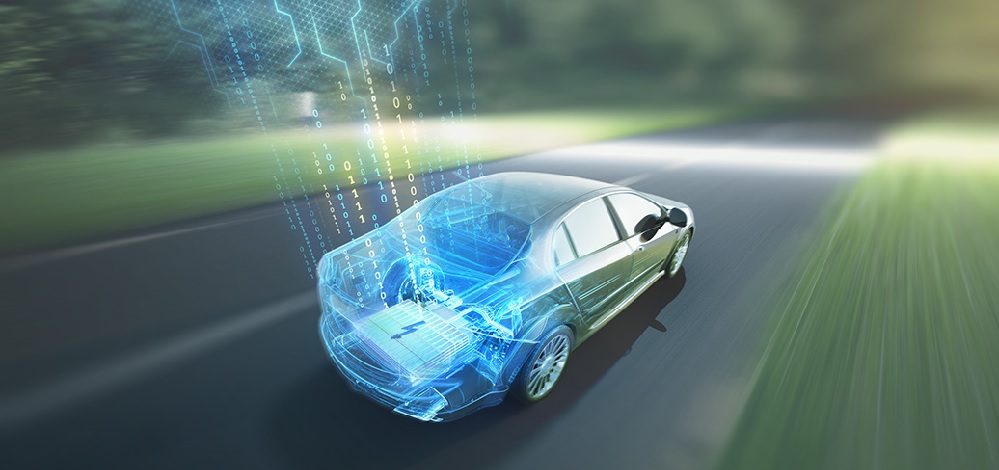Automotive Landscape and Business Drivers – The Future Car on E/E Systems Ep. 1 Transcript

Welcome to the Future Car podcast’s deep dive on E/E systems, a series of podcasts on the automotive industry from the perspective of the electrical and electronic systems, networks and software.
Please enjoy the transcript, below, or listen to the audio podcast.
Read the transcript:

Conor Peick: My name is Conor Peick, and I’ll be your host and moderator as we dive into this fascinating topic. But first, let’s meet the duo of experts that will be joining me:
Doug Burcicki: My name is Doug Burcicki – I’m responsible for the Automotive & Transportation Heavy Equipment Industries within Integrated Electrical Systems, part of the Digital Industry Software organization, within Siemens.
Dan Scott: I’m Dan Scott. I’m also from the Integrated Electrical Systems segment. I’m the Marketing Director. Previous background: I’ve worked in the automotive industry for 15 years or so in a variety of different roles from Chief Engineer, to Sales, to Project Management, working for a variety of suppliers, tier ones and OEMs.

Conor: Doug and Dan are both the owners of impressive resumes and decades of industry experience. Throughout this series, I will do my best to tap into their expertise to illuminate current trends in the automotive industry, including the development of advanced E/E systems. To begin today’s discussion, I asked Doug and Dan to describe the state of the industry today, and what’s driving innovation.
Doug: Yeah, that’s obviously a very large question. I guess one way to start is just to look at the headlines, some of the things that we see and hear about every day. We know that there’s been a tremendous amount of focus from players traditionally not part of the automotive industry, over the past ten years have been investing in and moving into the market, challenging the incumbents and the legacy OEMs, both from a traditional model perspective or business model perspective as far as putting a competitive product out on the market. But they’ve also introduced a new approach to the business models and an expansion of the business models, so to speak.

They found new ways to generate revenue and profits that go beyond the traditional sale of a vehicle to a consumer. They’ve developed ways to try to monetize that hardware after the point of sale, much to the same extent of the business model, as you would see with the mobile phone industry, that’s evolved over the last ten to 15 years, where most of those companies make their money on apps and software sales after the hardware – the phone itself – is sold to the consumer. And you’re seeing automobile turning into that type of product in the marketplace today.
Dan: Yeah, and from my perspective, like Doug is saying, it’s been quite an unprecedented last decade or two in the automotive industry. Just that shift we’ve had of 70 or 80 years of kind of predominantly mechanical machines – whether that’s hydraulics or mechanical – even from the early ‘90s, from getting ABS braking and things coming in, is beginning to increase. And certainly over the last 15 to ten years, an acceleration in EE systems, electronics and software coming into the vehicle, driving some of the stuff Doug’s talking about – shifts in business models and the whole landscape that’s enabled new entrants to come in with new players into the industry – from areas that 20 years ago would not be considered –companies coming in from traditional software backgrounds.
Doug: These observations are very accurate with what we see every day. And we hear headlines about all these, for lack of a better term, ‘sexy trends’, things like autonomous vehicles. It’s the holy grail in the auto industry right now to have the first level-five capable system developed. We are years away from that for a multitude of reasons, but the ultimate objective is no different. But there’s a lot of steps in between that we’re going to get to on the way, such as a greater proliferation of ADAS systems that enable the users of the vehicles to drive more effectively, efficiently and safer, both for themselves as well as pedestrians on the street. Advances in technology are essential to hit those interim milestones along the way. And, as Dan said, there’s been a gradual and consistent migration from mechanical to electrical and electronic – and now we’re moving into a software-defined vehicle era. It’s a much different environment than these OEMs that have existed in many cases for well over ten0 years, where they’re developing the traditional vehicles that we’ve been driving for decades, as well as trying to develop the capabilities to meet these new entrants into the market to compete with.
So, they must adapt. And it’s not just technology – it’s the way they’re structured, it’s the skill sets they hire, it’s how they develop the product, it’s the validation and timing of their development activities across multiple domains, that all must be managed in a much different manner if they’re going to bring together what’s essentially a holistic vehicle environment to attain these levels of ADAS and autonomy. Also, there is a more fundamental aspect of these vehicles, which is the electrification of the vehicle itself, moving away from combustion engine designs, or hybrid engines into ten0% BEV architecture or rechargeable architecture that drives different vehicle configurations. And it’s electrical, it’s mechanical, it’s software, it’s the network in the vehicle itself – they’re all interrelated and interdependent. And that’s where Siemens has something to offer and contribute to this evolution of the industry. Siemens has spent a lot of time, money, and effort in integrating different cross-functional capabilities that quite honestly don’t exist in any other company in the world to the extent that we offer them.
Conor: So, overall, we have an industry that is experiencing a lot of change and is revolutionizing in many ways, as you mentioned, Doug. I’m curious if we could dive into the path that has led us here, the changes that have occurred over the last ten years or however far back we need to go. We’ve talked about this steady transition from mechanical to electrical and electronics, and now we’re switching into software-defined vehicles. I’m curious to get you guys’ comments on that transition, and how that’s set up where the industry is, and where it’s going today?
Dan: I think it’s an interesting one. If you look at it not just from a technology point of view, but from an organizational point of view, where you have existing incumbent OEMs, coming from predominantly – not exclusively – that mechanical background and electrical, and needing to make that shift into software and networks, into caring more about the details of the electronics, about the ICs and about some of those things, which historically has been very much pushed out to tier one or to tier two suppliers. I think that is causing a massive reexamining for traditional OEMs of their core competencies, where they can really add value. It is interesting when you compare them to startups, or to new entrants, who have come in with natively more software skills – used to the rapid development cycles, agile processes and ways of iterating.
But they’re coming up against companies like Tesla –when you get into manufacturing vehicles, in large numbers, there’s a whole load of IP, skill, knowledge and experience and getting vehicles homologated and into production – a second nature, well established and developed for existing automotive OEMs – startups are having to bat up against this and get products into the market. Whereas, traditional OEMs, there is a shift from the longer cycles of product development into much faster iterations, over-the-air updates, and functionality being pushed out to vehicles post-production. These are some of the cultural and skills challenges that the automotive industry is continuing to grapple with in terms of how they manage it.
Conor: Do they set up separate business units of software people? Do they try and integrate them into existing product teams? How do they kind of manage that in a way that enables all the different domains that need to integrate and talk together to actually produce these super complicated vehicles, with networks, embedded software, electrical, mechanical, hydraulics – everything that needs to come together into one integrated package to deliver the features, the functionality that the customers are looking for.
Doug: All these things boil down to the business, right? At the end of the day, all these companies, aside from the cars and the technology, must be profitable, make money and return profits to their shareholders. So, there’s business challenges that they struggle with. And in my experience, over the last ten years, the increasing levels of complexity is one of the biggest challenges for any of these companies, no matter what their size. And it’s different types of complexity. You have sheer part number complexity, where you have vehicle variants that could have literally millions of part-number combinations, depending on which feature options the consumer desires on that vehicle.
You also have the complexity of subsystem integration. An example of that is an active cruise control system was essentially an integration of multiple systems before there was just a cruise control system, right? And all it monitored was your vehicle, not anything around it. An active cruise control system integrates additional sensors and sensor fusion and analysis. Then it acts on that analyze-data input. So, now you have an interactive system. And then you start integrating these systems further to come up with safety packages that are cross-functional with lane departure warning systems, auto parking systems, concierge systems or valet systems. There’s an inner increasing level of interoperability and a subsystem functionality that didn’t exist just five years ago.
And those engineering teams, the tools that they work on are different. They don’t communicate with each other. You have engineers and groups that handoff data to other engineers and groups that they didn’t have to even consider in the past. And they don’t communicate and talk, and they’re not organized to operate in that fashion historically, so they must go through a business process and organizational transformation. So, many of these challenges manifest themselves in different ways. It’s not just the complexity that you have to address. It’s your organization to address the complexity.
So, it goes back to the point that Dan was making about those challenges are merely tools or process. And that integration is becoming more of a top-five concern for any engineering leader in these companies. Again, because of the speed of change, historically, we haven’t developed engineering teams that if you were a hardware engineering, you didn’t really care about the software or the network that the device that you were designing connected or interfaced to. But those days are gone, where these companies are trying to make holistic design decisions because there are trade-offs and impacts; the lines of code, and the software you write has a direct impact on the physical EDS or wiring implementation, which has a direct impact on weight, with an impact on vehicle range. So, these things are all intertwined, and they can’t be developed independently in silos.
The biggest challenge that all of these companies face – and it’s because they have to balance; they can always do things faster, but then it means with less quality or reliability. And that’s the speed to market – development, speed and turnaround. There’s a continuous effort to shorten development time to get the automobile products in line with consumer electronics and the content that is driving the connectivity, the connected aspect of the vehicles; consumers is one of the number one priorities when they make a purchase, at least in the younger generations and the future buyers of these vehicles that the OEMs are concerned about.
When you put the power and experience from an OEM that’s been building real-world cars for ten0 years, and they apply themselves to these greater initiatives, technology-wise, I think you’ll see some of them close the gap relatively quickly on where some of the new entrants are. So, there’s been a lot going on in the last ten years, but I think the next ten years are going be even more exciting.
Conor: Yes, that’s an interesting direction, I think that we could take our discussion to, what do the next ten years look like? And maybe a few things I’d like you guys to discuss is, Doug, you mentioned legacy OEMs being at a crossroads perhaps, at a point of where they need to start transitioning to meet these new demands for connectivity, and technology, and automation – all these types of things. Where do you see the next ten years of this industry moving?
Doug: The next ten years are going to be about execution. I think a lot of companies have been developing strategies and putting some pieces together, whether they’ve developed internal groups or capabilities, or carved out teams to focus on new and emerging areas of focus, or acquired entities, similar to how GM acquired Cruise Automation years ago to get a head start on autonomous vehicle technologies. And they’ve applied aspects of that to their core business, but they’ve essentially run it as a separate standalone entity for the most part. And they recently invested in Nikola Trucks – licensing their battery cell technology to Nikola and actually producing the physical vehicles for themselves. So, you see these different business models or different approaches to business that you wouldn’t have historically seen. Rivian is another good example. Their business model was to develop their own vehicle, but also to develop on a platform that they would license the technology out to competitors or other players in the industry. The have been very successful in doing that, with multiple OEMs – Ford, Rivian, and Cox Automotive are very heavily invested in them. And now, they have other burgeoning relationships with other OEMs to supply them with EV powertrain.
So, there’s different models out there that are working, and they’re being valued and recognized. I think for the legacy OEMs, they are responding to these challenges, but they can’t just walk away from their current core business. So, it’s challenging for them, because they’re still trying to develop that portfolio of vehicles that they’ve been supporting for decades – and you can’t just flip a switch and change everything to an electrified vehicle powertrain or an autonomous vehicle, right? It takes years of development and concerted effort and expense.
And the problem is, the return on some of that investment is quite far away. So, it’s hard for them to justify pouring all of that focus and investment into areas where they don’t see the monetary return for years, if not decades. Therfore, they’ve been a little bit slower about it because they’ve had to be. They’ve had to be more measured in their successes and their risk, but you’re seeing that they’re making those hard shifts. Mercedes has already made a hard commitment to be a fully electrified portfolio of products – Volvo has done the same – GM is on the same path. So, we are seeing that shift, and those decisions are taking place.
I think that the OEMs are in a race, and they all know that the only way to get there is through significant investment –a large part of that investment is in our electrical architectures. So, if you look at where EVs have been over the last 20 years, they’ve been a fringe commodity – or actually not a commodity or for certain segments of the consumers – but very small segments. And part of it is they have been ugly. They have not been attractive vehicles. That goes back to the fact that they’ve been built on vehicle chassis and frames and architectures that were originally designed for internal combustion engines.
So, packaging wasn’t right, it wasn’t great, and the battery technology wasn’t where it needed to be to optimize packaging availability. There’s been a tremendous amount of advancements in the area that have come to the point where OEMs have very cost-effectively built bespoke architectures around EV-intended vehicles from day one, not retrofitted vehicles. And now you’re seeing a generation of vehicles that are beautiful, they’re fun to drive, they’re attractive – some of the most attractive vehicles on the market in some cases – and people now want to buy them for compelling reasons. And the business proposition behind EVs is becoming much more attainable for the average consumer as well.
So, now we’re getting to the point where the big players in the industry are committing to economies of scale – in many cases, like GM and Tesla developing their own battery plants. So, you’re going to see the economies of scale come into play now and it will become a more accessible, more affordable option for the everyday consumer. So, that is where I think we’re going to see the greatest technology evolution in the auto space over the next ten years. Also, in parallel, behind the scenes will be the continuous evolvement of AV. But I think what’s really going to drive the AV is level two, three, and to a certain extent, four capabilities. And a large part of that’s just driven by the legal requirements out of Europe with the NCAP requirements; a lot of things that are optional features in North America, from a safety perspective, are going to become de facto standard features on every vehicle sold in Europe. So again, that’s just going to make these things more accessible and affordable.
Conor: Yeah. Dan, what do you think?
Dan: I think Doug’s right, in terms of certain comments around the acceleration of movement to electric vehicles. I have definitely seen a similar de-prioritization of some of those level four, level five EV, AV push for autonomous vehicles. I thought that was interesting. I was reading yesterday that the German government – I think it was Angela Merkel herself – making comments on a proposal, where they’re going to allow level four or five vehicles to be tested in Germany to put into law sometime in the next 12 months or proposed for that. And, the same in California. You get different pockets, and I guess that’s why it’s difficult to comment on automotive, because there’s very different emphases in various regions. So, in China, there’s a relatively massive electric vehicle market. In the US slightly less so. In Norway, huge. In the UK, relatively small. So, I think it’s going to be quite a lot of localization in terms of some of these trends for electric vehicle autonomy.
I do think one of the things Doug was addressing was the move to virtual validation, and it’s more on the process side rather than the business approach. But I think that the pain that organizations feel when they hit those integration points is very real. As this level of complexity in vehicles has exploded, it’s become more obvious that that’s a pain point. I remember my days when I was a control software engineer, and I would get into a prototype vehicle that we had just written some software for, and you are hoping that the same assumptions you made about the way the network signals were scaled, was the same as the network design guys or electrical people made about the networks. And just that level of integration when you’ve got batteries, power electronics, high-speed motors, and layered on top of that is all the autonomous stuff in terms of lidar and radar with different technologies. Also, the amount of data is massively increasing, keeping organizations aligned and keeping development processes for these parallel domains aligned. So, you’ve got to be coming over within the next ten years to be one of the highest priorities for development organizations, getting products to market, not just quickly, but to market in a way that they’re reliable, robust, without massive warranty issues because of challenges. And you’re able to test vehicles and obtain a higher level of confidence much earlier in the development process. Every organization is really trying to push towards that, and I think the ones that will really succeed are the ones that are more able to coordinate between these different development streams, whether that’s electrical, software or mechanical. So much of this is having tools, processes and underlying data that can be exchanged and integrated, using it together, so people are not working off their own separate assumptions, but there’s a common approach to things as a greater coherency, in terms of how products are developed. People can get a snapshot across multiple domains rather than just their own silo that they’re looking at. So, I think all these technology trends are driving shifts in organizations, and the ones that can adapt to those best, will succeed. As we speak to our customers around the world, that’s what we’re seeing, because there are different levels of maturity in product development for various organizations. You see ones succeeding that are more able to embrace digitalization and that change the way they develop products.
Conor: The automotive industry is in the middle of a major shift. The electrical, electronic and software content of vehicles continues to grow, both incentivizing and necessitating new organizational structures and business models. At the same time, the level of competition is increasing as startups, tech companies and traditional OEMs all vie to bring innovative vehicles to market.
In episode two, Doug, Dan and I continue our discussion and consider some of the impacts the COVID-19 pandemic has had on the automotive industry. This has been Automotive E/E Systems Revolution, I am your host Conor Peick, thank you very much for listening!
Siemens Digital Industries Software drives the transformation to enable a digital enterprise where engineering, manufacturing, and electronics design meet tomorrow.
Xcelerator is a comprehensive, integrated portfolio of software, services and an application development platform. The portfolio accelerates the transformation of businesses into digital enterprises. It unlocks a powerful industrial network effect – essential requirements to leverage complexity as a competitive advantage, no matter the industry or company, to transition seamlessly to create tomorrow’s complex, efficient machines.


